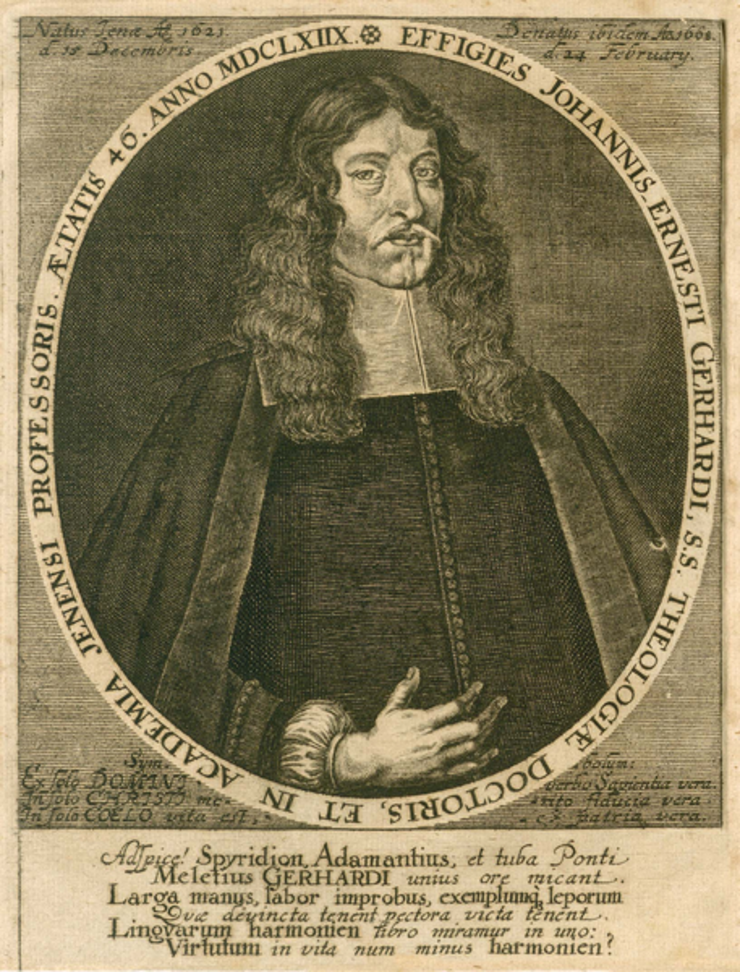
funded within the HERA project "Encounters with the Orient in Early Modern Scholarship", in cooperation with Prof. Charles Burnett (The Warburg Institute, London UK), Dr. Jan Loop (University of Kent at Canterbury, UK), Prof. Bernd Roling, Freie Universität Berlin), Prof. Outi Merisalo (University Jyväskylä, Finland), Prof. Gerard Wiegers, (University of Amsterdam). Duration: 3 years, 2013-2016
Johann Gerhard, orientalist educated theologian and one of the leading Lutherans in Germany, considered Hebrew the "matrix omnium aliarum linguarum"; the newer idioms were burdened with the original sin of Babel, only those of the Semites were not, because they had not participated in the building of the tower. Gerhard's son, Johann Ernst Gerhard the Elder (1621-1668), directed his interest early on to these "Semitic" languages. At the age of 26, in 1647, he republished Wilhelm Schickard's Hebrew grammar and wrote as an appendix his own Harmonia linguarum orientalium, scil. It is the time when something like a Semitic language family is just beginning to emerge in research : Christian Rave publishes his Generall Grammer for the Ebrew, Samaritan, Calde, Syriac, Arabic, and Ethiopic Tongue in 1648.
For Johann Ernst Gerhard there is an unusually favorable source situation: In the Gotha Research Library not only his printed works and the 6000 volume library (by him and his father) are preserved, but also 1450 letters to him, notebooks, the travel diary of his Peregrinatio academica as well as the annotated Wittenberg dissertations. In addition, the genealogical book that he kept on his peregrinatio has been made available to us from a private source. This makes it possible to examine him as an example of the type of theologically influenced Orientalist.
Since 1644 Gerhard had a friendship and a close exchange of letters with Hiob Ludolf, the three years younger - at that time twenty years old - student from Erfurt, who was interested in oriental languages and especially in Ethiopian. Ludolf studied in Leiden from 1646 with Jacob Golius and Contantin L'Empereur, and then traveled to Paris as a tutor to Grotius's successor as Swedish envoy to the French capital, Baron Schering von Rosenhahn. After Rosenhahn sent him to Rome, where Ludolf came into contact with Ethiopians, Ludolf followed his master around 1650 to Ninköping and Stockholm, where numerous scholars had gathered in Queen Christina's circle, not least the linguists Christian Rave and Samuel Bochart. From there, Ludolf recommended his friend Gerhard to numerous Orientalists in the Netherlands when the latter embarked on his own peregrinatio academica in the spring of 1650.
After his studies in Wittenberg and his peregrinatio to Holland, France and Switzerland, Gerhard first made a career as a theologian at the University of Jena. He published on the harmony of the Gospels and on numerous exegetical and theological questions. It was not until the mid-1660s that he returned to his orientalist interests. And he did so with two series of publications pursued simultaneously: In the first, he illuminated the various Oriental churches; the second was even more ambitious, for it led beyond the circle of Oriental churches by endeavoring to tract the religions of the whole world.
As the first fruit of the HERA project, the anthology "The Teaching and Learning of Arabic in Early Modern Europe," edited by Jan Loop, Alastair Hamilton, and Charles Burnett, was published by Brill in Leiden in February 2017. Through 13 case studies, this volume offers an innovative look at the efforts of early modern Europeans to master the Arabic language. Like the HERA project in general, the careful case studies in this volume strive to explain the contemporary contexts that made learning a difficult Oriental language possible and prestigious-even in parts of early modern Europe where such knowledge served no immediate practical purpose. The book is also available via open access.